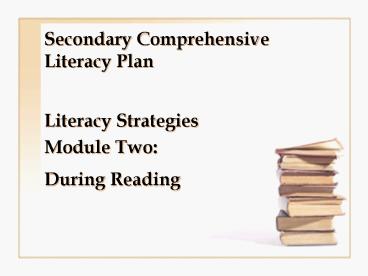Secondary Comprehensive Literacy Plan - PowerPoint PPT Presentation
1 / 17
Title:
Secondary Comprehensive Literacy Plan
Description:
They learn to relate the new word to known words. They learn to make meaningful sensory ... students aware of multiple information sources, and compliments and ... – PowerPoint PPT presentation
Number of Views:24
Avg rating:3.0/5.0
Title: Secondary Comprehensive Literacy Plan
1
Secondary ComprehensiveLiteracy Plan
- Literacy Strategies
- Module Two
- During Reading
2
12 Literacy Strategies
- The ultimate goal of strategic instruction is
independence. - K-W-L
- Text Structure
- Anticipation Guide
- Word Sorts
- Modeled Fluency
- Graphic Organizers
- DR-TA
- QAR
- Independent Study Strategies
- RAFT
- Summarization
- Reciprocal Teaching
3
Modeled Fluency
- Modeled fluency (Rasinski, 2002) is teaching
learners to read orally with speed and accuracy
by listening to a model of the assigned text. - Fluency can be taught directly, and it improves
as a consequence of learners reading a lot of
materials that are within their instructional
range. - By supporting struggling readers through oral
reading, students benefit by improving their
reading skills while learning the assigned text.
4
Modeled Fluency
- Learners benefit from modeled fluency
- They learn to pronounce words correctly
- They learn to read with precision and speed
- They learn to read with confidence
- They learn comprehension
5
Modeled Fluency
- Sample Lessons
- Before reading
- During reading
- After reading
- Refer to page 56 in the
- Comprehensive Literacy Plan
6
12 Literacy Strategies
- The ultimate goal of strategic instruction is
independence. - K-W-L
- Text Structure
- Anticipation Guide
- Word Sorts
- Modeled Fluency
- Graphic Organizers
- DR-TA
- QAR
- Independent Study Strategies
- RAFT
- Summarization
- Reciprocal Teaching
7
Graphic Organizers
- Graphic organizers (Vacca Vacca, 1996) are
pictorial representations of how ideas in a text
are connected and organized. - Graphic organizers serve as tools for fine-tuning
comprehension, taking notes, and remembering
information. - Graphic organizers are useful in narrative,
expository, and persuasive writing by helping
students focus on the topic at hand.
8
Graphic Organizers
- Learners benefit from graphic organizers
- They learn to analyze essential and
non-essential attributes - They learn to describe the concept
- They learn to relate the new word to known words
- They learn to make meaningful sensory
connections - They increase retention
9
Graphic Organizers
- Sample Lessons
- Before reading
- During reading
- After reading
- Refer to page 59 in the
- Comprehensive Literacy Plan
10
12 Literacy Strategies
- The ultimate goal of strategic instruction is
independence. - K-W-L
- Text Structure
- Anticipation Guide
- Word Sorts
- Modeled Fluency
- Graphic Organizers
- DR-TA
- QAR
- Independent Study Strategies
- RAFT
- Summarization
- Reciprocal Teaching
11
DR-TA
- The task of a Directed Reading and Thinking
Activity (Stauffer, 1969) is to generate
predictions about the material to be read, and
then refine these predictions while reading. - There are four steps to this strategy
- Predict Students predict what they think will
be covered - Read Students read a few paragraphs or pages
of the text - Confirm Students compare their predictions
with the text - Resolve Students summarize and evaluate the
text - This strategy has many uses and can be effective
for fiction or content texts.
12
DR-TA
- Learners benefit from DR-TA
- They learn to make predictions prior to reading
- They learn to compare their predictions to the
actual text - They learn to summarize and evaluate the text
13
DR-TA
- Sample Lessons
- Before reading
- During reading
- After reading
- Refer to page 75 in the
- Comprehensive Literacy Plan
14
12 Literacy Strategies
- The ultimate goal of strategic instruction is
independence. - K-W-L
- Text Structure
- Anticipation Guide
- Word Sorts
- Modeled Fluency
- Graphic Organizers
- DR-TA
- QAR
- Independent Study Strategies
- RAFT
- Summarization
- Reciprocal Teaching
15
QAR
- QAR (Raphael Pearson, 1982 Pearson Johnson,
1978) is a process of describing and illustrating
for students that there are three types of
questions and possible places for finding answers
to these questions. - The three types of questions are
- Textually explicit Literally stated in the
text - Textually implicit Suggested or implied in the
text - Implicit In the readers background knowledge
- QAR makes students aware of multiple information
sources, and compliments and supports graphic
organizers.
16
QAR
- Learners benefit from QAR
- They learn the sources of information in the
text - They learn how to question the text
- They learn how to find and evaluate answers to
their questions
17
QAR
- Sample Lessons
- Before reading
- During reading
- After reading
- Refer to page 81 in the
- Comprehensive Literacy Plan































